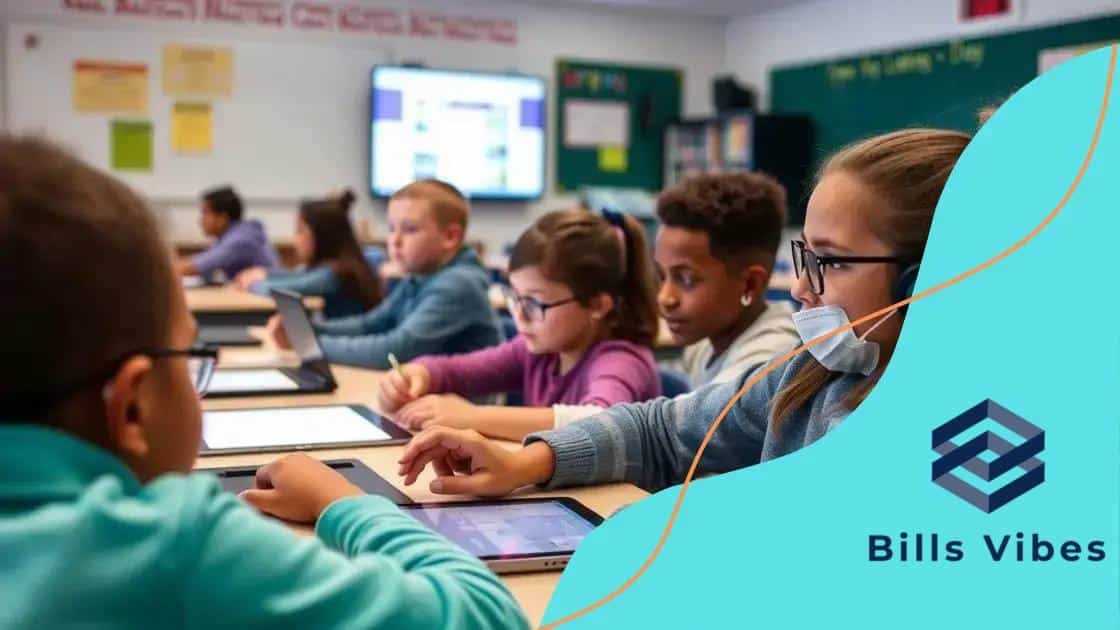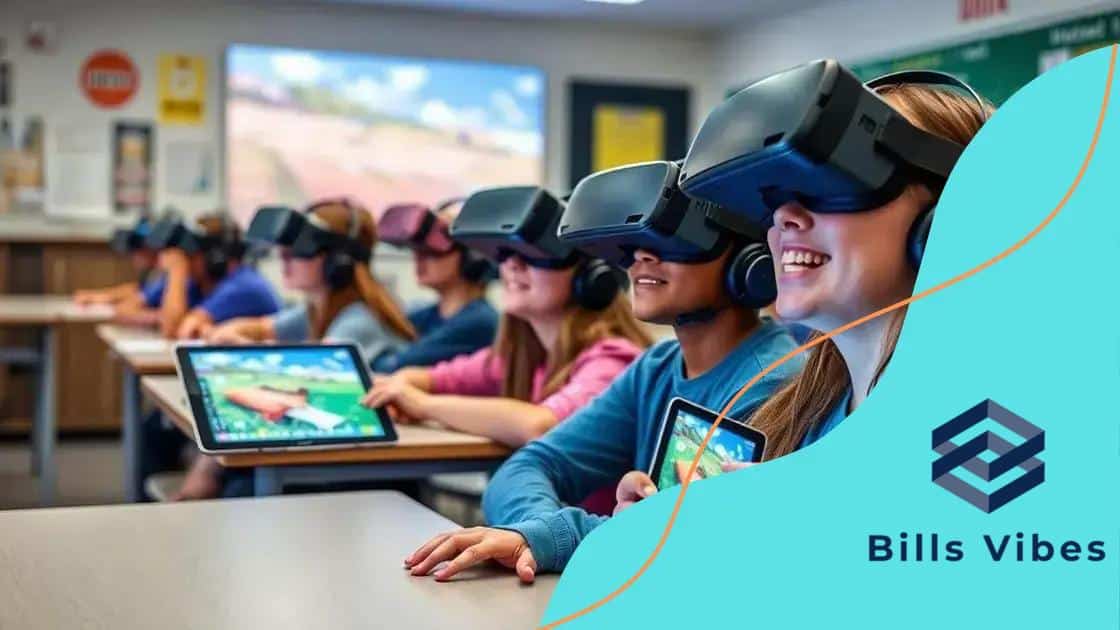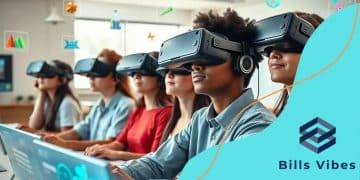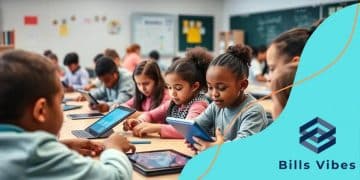K-12 digital learning trends shaping the future

K-12 digital learning trends are transforming education through personalized learning, immersive technologies like VR and AR, and a focus on social-emotional learning, enhancing engagement and catering to diverse student needs.
K-12 digital learning trends are reshaping the educational landscape, presenting new ways for students to engage and learn. Have you ever wondered how technology influences classrooms today? Let’s dive into these exciting developments.
Emerging technologies in K-12 education
Emerging technologies in K-12 education are transforming how learning happens. Students are increasingly exposed to innovative tools that enrich their classroom experiences. This shift is not just about new gadgets; it’s about enhancing the way educators teach and how students learn.
Key Technologies Impacting Education
Several technologies are making waves in K-12 classrooms:
- Artificial Intelligence: AI is personalizing learning, allowing tailored educational experiences.
- Virtual Reality (VR): VR immerses students in different environments, making subjects like history or science more engaging.
- Learning Management Systems (LMS): LMS platforms streamline course management and enhance communication between teachers and students.
Integrating these technologies can lead to improved student engagement and better learning outcomes. For instance, AI can automate grading and provide real-time feedback, which helps teachers focus on personalized instruction.
The Role of Data Analytics
Data analytics is another critical technology impacting K-12 education. By analyzing data from assessments and engagement metrics, schools can pinpoint students who may be struggling and intervene promptly. This proactive approach ensures that no child falls behind.
Additionally, these insights can help educators tailor their teaching methods. For example, understanding which topics students find challenging allows teachers to adjust their lesson plans accordingly. This tailored instruction is an essential aspect of modern education and one that technology greatly supports.
As we move further into the digital age, the collaboration between educators and tech developers will continue to shape the educational landscape. The future of K-12 education is filled with potential as these technologies evolve and adapt to meet the needs of diverse learners.
Personalized learning approaches
Personalized learning approaches in K-12 education are revolutionizing how students engage with material. By adapting to individual needs, these methods cater to diverse learning styles. This tailored approach helps students grasp concepts at their own pace.
Benefits of Personalized Learning
There are several advantages to implementing personalized learning:
- Improved Engagement: Customized lessons keep students more interested and motivated.
- Increased Achievement: Individual pacing allows students to master topics before moving on.
- Enhanced Learning Ownership: Students take more responsibility for their learning and outcomes.
By focusing on these factors, educators can create a more effective learning environment. For instance, when students are able to choose their projects or learning modules, they often show greater enthusiasm and commitment.
Technology’s Role in Personalization
Technology plays a crucial role in facilitating personalized learning. Learning management systems (LMS) help teachers monitor progress and adapt lessons accordingly. These platforms enable the collection of data, allowing educators to identify strengths and weaknesses in students’ understanding.
For instance, adaptive learning software adjusts difficulty based on student performance. This real-time feedback ensures that learners are constantly challenged but not overwhelmed. Additionally, online resources can provide different materials that cater to various interests and skill levels.
Overall, the integration of personalized learning approaches enriches the educational experience. With a focus on the individual, students can thrive in their academic journeys, putting them on the path to success in future endeavors. This shift toward tailored instruction signifies a meaningful advancement in K-12 education.
The role of virtual and augmented reality

The role of virtual and augmented reality in K-12 education is becoming increasingly important. These technologies offer immersive learning experiences that engage students in ways traditional methods cannot. By using VR and AR, educators provide students with unique opportunities to explore complex subjects in an interactive manner.
Benefits of VR and AR in Education
Both virtual and augmented reality bring several advantages to the classroom:
- Enhanced Engagement: Students are more likely to participate actively when using VR and AR.
- Improved Retention: Immersive experiences help students remember concepts better.
- Safe Learning Environments: Students can practice skills in a controlled setting without real-world risks.
For example, in a biology class, students can use VR to explore the human body in 3D, allowing them to understand anatomy visually and interactively. This approach makes learning much more engaging compared to reading from a textbook.
Applications of VR and AR
Virtual and augmented reality have various applications in K-12 education. Teachers can use these technologies to create simulations for historical events, allowing students to experience them as if they were there. AR can enhance textbooks, overlaying information on images or providing interactive elements.
Moreover, in subjects like physics and engineering, students can visualize theories and experiments, enriching their understanding. By interacting with three-dimensional models, learners can connect theory with practice seamlessly.
These technologies not only support engagement but also promote creativity. Students can create their own VR environments or AR projects, leading to deeper exploration and innovation. As virtual and augmented reality continue to develop, they’ll play a crucial role in shaping the future of education, making learning more effective and enjoyable.
Challenges in digital learning environments
Challenges in digital learning environments can impact the effectiveness of education. While technology offers many benefits, it also presents obstacles that educators and students must overcome. Understanding these challenges is crucial for creating a better learning experience.
Common Challenges Faced
Many students encounter difficulties in digital learning:
- Lack of Engagement: Some students may find it hard to stay focused in an online setting.
- Technical Issues: Connectivity problems and device limitations can disrupt learning.
- Access to Resources: Not all students have equal access to devices and reliable internet.
These factors can lead to a gap in educational outcomes. For instance, when students are unable to participate fully due to technical problems, their learning suffers. Educators need to be aware of these risks to provide adequate support.
Addressing the Challenges
Addressing the challenges in digital learning environments requires creativity and resourcefulness. Teachers can implement strategies to enhance engagement, such as using interactive content and fostering collaboration among students. Platforms that facilitate group work help create a sense of community.
Moreover, providing training for both teachers and students on how to use digital tools effectively can mitigate technical issues. Schools can also work towards ensuring all students have access to necessary resources, such as devices and internet connections. This could include partnerships with local organizations to distribute technology.
Even as technology evolves, it’s essential to stay aware of these ongoing challenges. By taking proactive measures, educators can create a more equitable and effective digital learning experience for all students.
Future predictions for K-12 learning
Future predictions for K-12 learning suggest an exciting evolution in education. As technology advances, the way students learn and interact in the classroom will change dramatically. Educators, students, and parents alike should prepare for a new landscape that prioritizes flexibility, accessibility, and engagement.
Emerging Trends in Education
Several trends are likely to shape the future of K-12 education:
- Increased Use of AI: Artificial intelligence will play a major role in personalizing learning experiences.
- Blended Learning Models: More schools will adopt a mix of in-person and online instruction to enhance learning.
- Focus on Social-Emotional Learning: Educators will emphasize the mental well-being and emotional intelligence of students.
These trends indicate a shift toward a more individualized educational experience that addresses the unique needs of each student. For example, AI might analyze student performance data to recommend tailored resources and exercises, ensuring that students are challenged at their own level.
Impact of Technology on Learning Environments
Technology will also redefine the physical and virtual learning environments. Classrooms may incorporate more collaborative spaces where students can work together in person or online. This setup encourages teamwork and promotes problem-solving skills.
Furthermore, virtual reality will likely become a commonplace tool, allowing students to explore complex subjects in a fully immersive environment. Imagine a history lesson where students can virtually visit ancient civilizations or a science class that simulates ecosystems around the world.
As we look ahead, it is clear that the future of K-12 learning will be more dynamic and inclusive. By integrating these advancements, educators can create environments where every student has the opportunity to thrive.
FAQ – Frequently Asked Questions about K-12 Digital Learning Trends
What are the main benefits of digital learning in K-12 education?
Digital learning enhances engagement, personalizes educational experiences, and provides access to a wealth of resources tailored to individual student needs.
How can educators implement personalized learning?
Educators can use technology, such as adaptive learning tools, to assess student progress and create customized lesson plans that suit each learner’s pace and style.
What challenges do teachers face in digital environments?
Teachers often encounter issues like lack of student engagement, technical difficulties, and disparities in student access to technology and resources.
What role will virtual reality play in future classrooms?
Virtual reality will provide immersive learning experiences, allowing students to explore complex concepts and subjects in ways that enhance understanding and retention.






